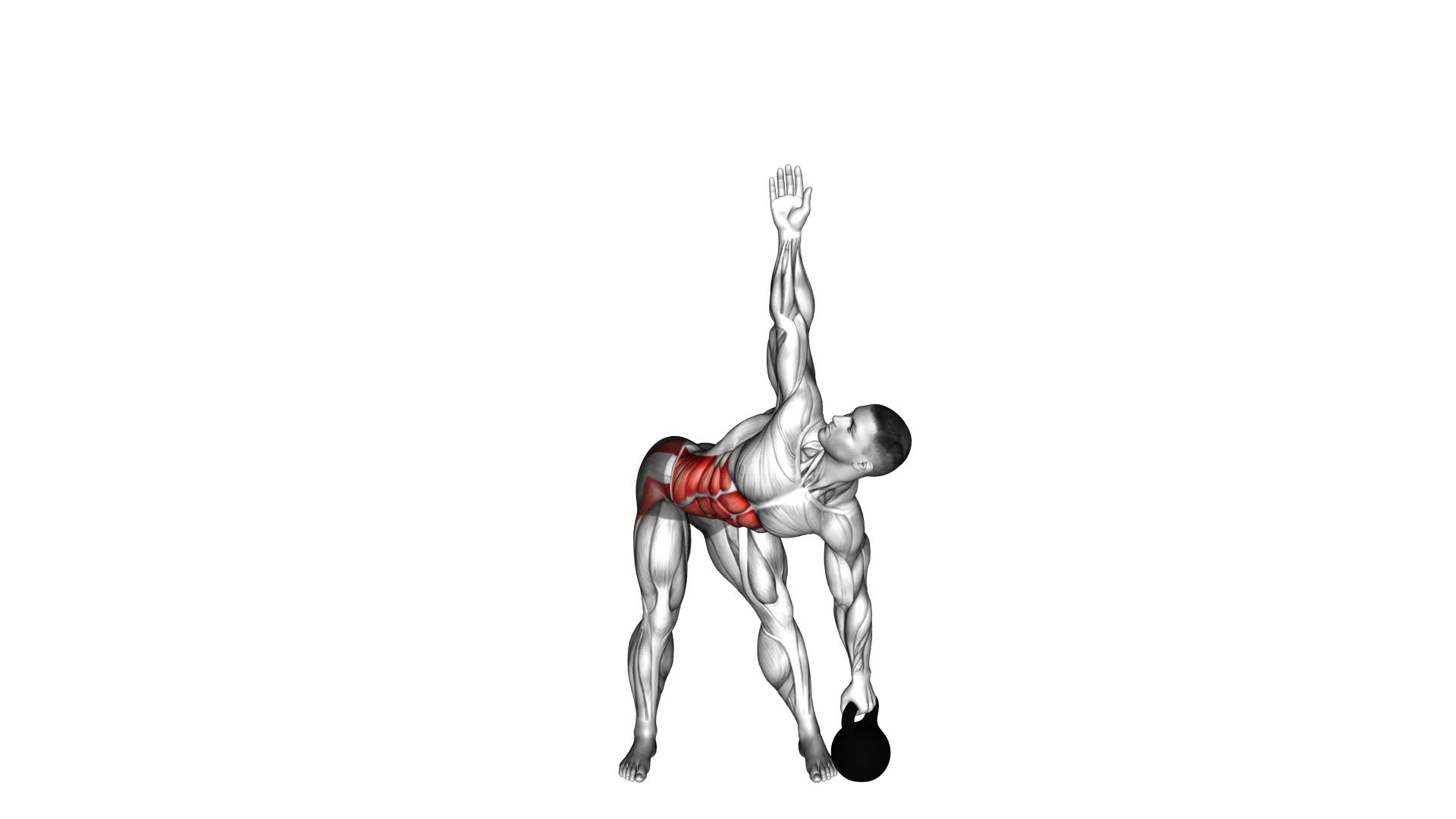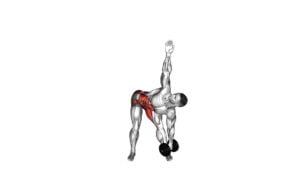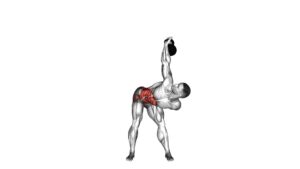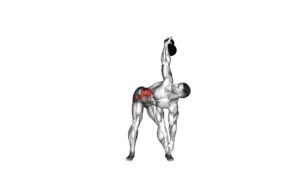Kettlebell Low Windmill – Video Exercise Guide & Tips

Are you looking to enhance your workout routine and strengthen your core? Look no further than the Kettlebell Low Windmill.
Watch This Exercise Video
This exercise targets multiple muscle groups and improves flexibility, all while providing a challenging full-body workout.
In this video exercise guide, you'll find step-by-step instructions and helpful tips to ensure proper form and technique.
Whether you're a beginner or an experienced fitness enthusiast, this guide will help you maximize the benefits of the Kettlebell Low Windmill.
Key Takeaways
- The Kettlebell Low Windmill targets multiple muscle groups.
- Proper form and technique are important for performing the exercise correctly.
- Common mistakes to avoid include bending knees too much and rounding the back.
- Variations and progressions of the Kettlebell Low Windmill can increase the challenge and intensity of the workout.
Benefits of the Kettlebell Low Windmill
You will frequently experience numerous benefits when incorporating the Kettlebell Low Windmill into your workout routine. This exercise offers various variations that can help you target different muscle groups and improve your overall strength and flexibility.
One of the key benefits of the Kettlebell Low Windmill is its ability to engage and strengthen your core muscles. As you perform the exercise, you're required to stabilize your body while moving the kettlebell in a controlled manner. This not only challenges your core muscles but also helps to improve your balance and stability.
In addition to core strength, the Kettlebell Low Windmill also targets your shoulder muscles. The rotational movement involved in the exercise works your deltoids, helping to build strength and definition in your shoulders.
Furthermore, the Kettlebell Low Windmill can also enhance your hip mobility. By performing the exercise in a controlled manner, you're required to move your hips through a full range of motion, which can help to increase flexibility and prevent hip tightness.
Proper Form and Technique for the Kettlebell Low Windmill
To perform the Kettlebell Low Windmill correctly, it's important to maintain a stable and controlled movement throughout the exercise. This will ensure that you engage the correct muscles and minimize the risk of injury. Here are some key points to keep in mind for proper form and technique:
- Kettlebell low windmill modifications:
- Start with a lighter kettlebell or no weight at all until you have mastered the technique.
- Use a wider stance for better stability.
- If you have limited flexibility, bend your knees slightly to make it more manageable.
- Core engagement in kettlebell low windmill technique:
- Keep your core muscles, especially your obliques, engaged throughout the entire movement.
- Imagine creating a straight line from your hand holding the kettlebell to your opposite foot.
- Focus on rotating your torso and maintaining a neutral spine position.
Common Mistakes to Avoid While Performing the Kettlebell Low Windmill
Avoid these common mistakes when performing the Kettlebell Low Windmill to ensure proper form and maximize the benefits of the exercise.
Maintaining the correct kettlebell low windmill form is crucial for preventing injuries and getting the most out of your workout. One common mistake is bending the knees too much. Remember to keep your knees slightly bent throughout the movement, but avoid excessive bending as it can compromise your stability and limit the effectiveness of the exercise.
Another mistake to avoid is rounding your back. Keep your spine straight and engage your core muscles to maintain stability and protect your lower back.
Additionally, be cautious of lifting too heavy of a weight. Start with a lighter kettlebell to master the proper technique before progressing to heavier weights.
Lastly, rushing through the exercise is a common mistake. Take your time and focus on the movement, ensuring that you're maintaining control and stability throughout.
Variations and Progressions of the Kettlebell Low Windmill
To further challenge yourself and continue progressing with the Kettlebell Low Windmill, explore different variations and advanced movements. Here are some progressions and modifications to try:
- Single Arm Low Windmill: Instead of using two kettlebells, hold one kettlebell in one hand while keeping the other hand free. This variation requires more core stability and balance.
- Bottoms-Up Windmill: Hold the kettlebell upside down by its handle, with the bell facing towards the ceiling. This variation increases grip strength and shoulder stability.
- Weighted Windmill: Hold a heavier kettlebell or add weight plates to the handle of the kettlebell to increase the load and challenge your muscles even more.
By incorporating these progressions and modifications into your Kettlebell Low Windmill routine, you can continue to improve your strength, stability, and flexibility. These variations provide an opportunity to target different muscle groups and increase the overall difficulty of the exercise.
Transitioning into the subsequent section about 'tips and tricks to maximize your kettlebell low windmill workout', it's important to remember to start with lighter weights and gradually increase the load as you become more comfortable with each variation.
Tips and Tricks to Maximize Your Kettlebell Low Windmill Workout
As you continue to challenge yourself with variations and progressions of the Kettlebell Low Windmill, there are several tips and tricks you can implement to maximize your workout.
First and foremost, it's important to focus on maintaining proper form throughout the exercise to prevent common injuries. Keep your back straight and core engaged, and be mindful of the alignment of your spine and shoulders.
Additionally, it's recommended to start with a lighter kettlebell weight and gradually increase as you build strength and confidence in your technique. This will help reduce the risk of strain or overexertion.
In terms of equipment, it's essential to use a kettlebell that's appropriate for your fitness level and goals. Choose a weight that allows you to perform the exercise with control and without compromising your form. It's also advisable to wear proper workout shoes with good support and grip to maintain stability during the movement.
Remember to warm up before starting your Kettlebell Low Windmill workout and cool down afterwards to prevent muscle soreness and promote recovery. Stretching your hamstrings, hips, and shoulders can also help improve flexibility and mobility, enhancing your overall performance.
Frequently Asked Questions
How Heavy Should the Kettlebell Be When Performing the Low Windmill Exercise?
When performing the low windmill exercise, it's important to choose the right weight for your kettlebell. The weight should challenge you, but also allow you to maintain proper form and balance throughout the movement.
Start with a lighter kettlebell and gradually increase the weight as you become more comfortable and confident with the exercise.
Can the Low Windmill Exercise Help With Improving Flexibility?
The low windmill exercise is a great way to improve flexibility. By incorporating this exercise into your routine, you can experience the flexibility benefits it offers.
It helps to stretch and strengthen the muscles in your hips, hamstrings, and core. Beginners can start with variations that involve using a lighter kettlebell or even just bodyweight. As you progress, you can gradually increase the weight and intensity.
Remember to always maintain proper form to avoid injury.
Is It Necessary to Warm up Before Performing the Kettlebell Low Windmill?
To avoid injury and maximize the benefits of the kettlebell low windmill, it's highly recommended to warm up before performing this exercise. Warming up helps increase blood flow to your muscles, improves flexibility, and prepares your body for the workout ahead.
It can be as simple as a few minutes of light cardio or dynamic stretches. If you're short on time, alternatives like foam rolling or mobility exercises can also help prepare your body for the low windmill.
Can the Kettlebell Low Windmill Be Modified for Individuals With Lower Back Issues?
If you have lower back issues, it's important to find modified variations of the kettlebell low windmill that won't aggravate your condition.
Before attempting this exercise, consult with a fitness professional or physical therapist who can guide you in finding alternative exercises that will target similar muscles without putting excessive strain on your lower back.
It's crucial to prioritize your safety and well-being during your workout routine.
How Often Should the Kettlebell Low Windmill Be Incorporated Into a Workout Routine for Optimal Results?
To achieve optimal results in your workout routine, it's important to incorporate the kettlebell low windmill.
This exercise targets various muscles, including your core, shoulders, and hips.
By regularly performing the kettlebell low windmill, you can improve your strength, stability, and flexibility.
It's recommended to include this exercise in your routine at least 2-3 times per week.
Remember to start with a weight that challenges you but allows for proper form to avoid injury.
Conclusion
In conclusion, the Kettlebell Low Windmill is a highly effective exercise for improving flexibility, core strength, and stability. By maintaining proper form and technique, you can avoid common mistakes and maximize the benefits of this workout.
Additionally, exploring variations and progressions can add variety and challenge to your routine. Remember to always prioritize safety and listen to your body.
Follow these tips and tricks to get the most out of your Kettlebell Low Windmill workout.

Author
Years ago, the spark of my life’s passion ignited in my mind the moment I stepped into the local gym for the first time. The inaugural bead of perspiration, the initial endeavor, the very first surge of endorphins, and a sense of pride that washed over me post-workout marked the beginning of my deep-seated interest in strength sports, fitness, and sports nutrition. This very curiosity blossomed rapidly into a profound fascination, propelling me to earn a Master’s degree in Physical Education from the Academy of Physical Education in Krakow, followed by a Sports Manager diploma from the Jagiellonian University. My journey of growth led me to gain more specialized qualifications, such as being a certified personal trainer with a focus on sports dietetics, a lifeguard, and an instructor for wellness and corrective gymnastics. Theoretical knowledge paired seamlessly with practical experience, reinforcing my belief that the transformation of individuals under my guidance was also a reflection of my personal growth. This belief holds true even today. Each day, I strive to push the boundaries and explore new realms. These realms gently elevate me to greater heights. The unique combination of passion for my field and the continuous quest for growth fuels my drive to break new ground.







